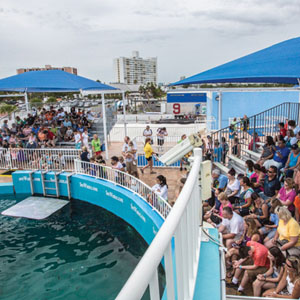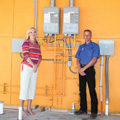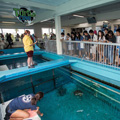Sustainability goal fuels Clearwater Aquarium expansion project. Clearwater Marine Aquarium is home to Winter, a dolphin who lost her tail in a crab trap and was subsequently fitted with a special prosthetic device.

Founded in 1972 as a sanctuary for local marine wildlife, the Clearwater (Fla.) Marine Aquarium has rescued, rehabilitated and – whenever possible – released more than 1,500 animals through the years.
A 13,000-sq.-ft. expansion project currently underway will permit CMA to dramatically enhance its ability to fulfill its core mission.
For example, its Animal Care Zone will see a doubling of its capacity for rescuing sea turtles. Meanwhile, the dolphin rehabilitation space will be enlarged by two-thirds to 250,000 gal., effectively tripling its space.
At the same time, Aquarium officials are intent on improving the experience of the thousands of visitors touring its facilities and attending its programs each year. The most visible upgrade will be the new dolphin complex, offering stadium seating for 800 people and an 800,000-gal.dolphin exhibit. The $12 million expansion will be completed this spring. The facility remains open during construction.
The expansion keeps sustainability in mind. A key part of the expansion centers on the installation of a new tankless water heating system. Local natural gas and propane products distributor Tempaco and manufacturer partner Noritz teamed up with Clearwater Gas Systems to donate, deliver and install three Noritz gas-fired tankless units that will perform vital roles in the expanded operation by furnishing ample supplies of hot water in four critical areas involving animal care:
- In the kitchen for food preparation for the dolphins, stingrays, river otters, sea turtles and other sea creatures residing at the aquarium;
- In the operating room where rescued, injured animals are surgically treated;
- In the locker room showers used by CMA trainers and volunteer divers after they have been inside the saltwater exhibits with the animals; and
- In the animal quarantine area that will supply hot water to the restrooms and necropsy room.“The need for animal rescue and care is very great, which is why we are so excited by the enhanced treatment and educational capabilities the expansion will bring,” CMA Vice President of Development Linda O’Reilly says. “The top-quality animal care we provide demands top-quality equipment, so our goal is to make the new aquarium a state-of-the-art facility.”
Hollywood hit
The expansion project is a direct byproduct of the success of the movie “Dolphin Tale,”filmed at CMA by Warner Bros.-based Alcon Entertainment during a three-month period in 2010. The movie portrays the friendship of a boy and a dolphin named Winter who lost her tail in a crab trap and was subsequently fitted with a special, prosthetic device that allowed her to swim like a normal dolphin. Since the movie’s release in September 2011, thousands of moviegoers from around the world have seen the film and then traveled to CMA to visit Winter and learn even more about her inspiring story.
“Since the movie’s release, we have seen a dramatic increase in visitors,” O’Reilly says. The aquarium was expected to reach 750,000 visitors in 2012, a 310% increase since the movie’s release.
Two miles away in downtown Clearwater, CMA opened a second facility that focuses on the filming of “Dolphin Tale.” This attraction is dedicated not only to the filming, but also to Winter’s story and to the engineering feat of recreating her new tail.
Nonetheless, CMA officials knew that a long-term solution to the increased foot traffic required significant expansion of the main facility on the water’s edge in Clearwater. They also recognized the movie’s popularity as an excellent opportunity to expand the Aquarium’s rescue capabilities. Once the decision was made to move forward, Clearwater Gas Systems became involved. CGS, in turn, asked its longtime partner Tempaco to provide the tankless water heaters.

Why tankless?
The popularity of tankless water heating has grown steadily over the past decade in the Clearwater market, CGS Gas Sales and Public Affairs Manager Kristi Cheatham says. She estimates nine of every 10 shipments from the utility’s warehouse currently are tankless models. “Our customers who need new water heaters invariably ask about tankless,” she adds. “We recommended tankless technology to the aquarium for the energy efficiency, of course, but also for the space savings. The Aquarium is situated on a very limited footprint. If they could save even an inch or two, they wanted to do so.”
That concern over space savings ultimately resulted in positioning the two units for the operating room and the kitchen about halfway up a three-story wall on the facility’s exterior. The units are protected overhead by a small roof through which the products of their combustion processes are vented to the atmosphere by an 8-ft. run of Category III stainless steel.
Tempaco Regional Sales Manager John Faulkner explains even though the water heaters are located outdoors, this venting was deemed necessary because of the units’ proximity to a pool area used by turtles and other sea creatures.
“We needed to divert the combustion gases up and away from the animals swimming below the water heaters,” he says.
Reginald Gholston, a Noritz service engineer, designed the system after walking the jobsite last February. Cheatham notes a CGS install crew had the units operational in three days despite having to pull a certificate of occupancy to run a new gas line.
“The permit was generated on a Monday afternoon and by the following Thursday the three units were tied into the gas meter,” she says. “We wanted to be certain the aquarium did not have to wait on CGS to get its hot water.”

Go green
Cheatham praises Tempaco for its enthusiastic and proactive involvement in the CMA project, as well as for its green beliefs.
“It would have been easy for Tempaco simply to donate a storage-tank model at a fraction of the cost, figuring Clearwater Gas would still get the natural gas load,” she says. “They recognized the aquarium’s goal was to go green and correctly concluded tankless was the right solution for this situation. We seldom have problems installing tankless because of the ongoing, hands-on training Tempaco provides our guys. They keep us up-to-date on new technological developments. It makes it easy for us.”
CMA Vice President of Operations Mike Hurst adds the aquarium expansion also features ProFlo 1.6-gpf water closets and wall-hung lavatories. Other plumbing-related products used in the expansion include: Elkay stainless-steel sinks; Delta Faucet showers, lav sinks and kitchen-related products; Zurn floor and trench drains; Zoeller pumps; Symmons mixing valves; and IPS Corp. Weld-On cements. Pipe, valves and fittings manufacturers include: Charlotte Pipe; FlowGuard (CPVC pipe and fittings); Silverline Plastics; Sanderson Pipe; Georg Fischer and Spears (PVC pipe, valves and fittings); and Asahi/America (valves). Oldsmar, Fla.-based HCS Plumbing is the plumbing contractor of record on the project.

Clearwater Marine Aquarium expansion
- New dolphin exhibit with stadium seating and new 800,000-gal. pool.
- Addition of the Jacobson Center for Marine Animal Care & Education.
- Enhanced educational exhibits and signage.
- Expanded viewing areas.
- Addition of a multilevel parking garage and expanded surface parking lot.
- New lobby, gift shop and ticketing area.Addition of a new Animal Care Zone, including:
- Doubling capability for sea turtle rehabilitation, depending on species and size.
- Increased dolphin rehabilitation space from 150,000 to 250,000 gal., which could triple rehabilitation capacity, based on circumstances.
- Increased overall rehab space, from 4,200 to 13,000 sq. ft.
- New fish quarantine/hospital area.
- State-of-art surgical suite and necropsy unit.
- Expanded life-support systems and generator.
- New otter rehabilitation facilities.
